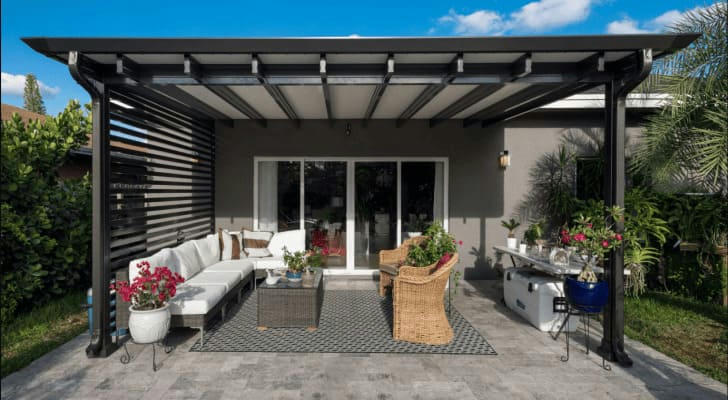Turn Home Repair Grants into Your Perfect Patio Roof
For U.S. homeowners, budget limitations often delay backyard upgrades like patio roofs. Yet government home repair grants funds for qualifying households—can turn this dream into reality. These programs, designed to improve safety and energy efficiency, may also cover outdoor living spaces. Discover how to leverage grants for your pergola, from eligibility to application success.

What Are Government Home Repair Grants?
Government home repair grants are financial assistance programs funded by federal, state, or local agencies to help homeowners maintain safe, energy-efficient, and structurally sound properties. Unlike loans, grants do not require repayment, making them an attractive option for qualifying households.
Key Programs :
HUD’s HOME Investment Partnerships Program: Supports low-income homeowners with repairs and modifications.
USDA Rural Development Home Repair Grants: Available to rural residents for health, safety, or accessibility upgrades.
Weatherization Assistance Program (WAP): Focuses on energy efficiency but may cover related structural improvements.
State-Specific Programs: Many states, like California’s CalHome Program, offer grants tailored to local needs.
How Much Can You Receive?
Grant amounts vary widely based on location, income, and program guidelines. For example:
USDA grants offer up to $10,000 for eligible rural homeowners.
HUD’s HOME Program may provide $5,000–$25,000 , depending on household size and income.
State programs often cap awards at $40,000 for major renovations.
Why Build a Patio Roof?
A patio roof or pergola isn’t just an aesthetic upgrade—it’s a functional investment. Here’s why it’s worth considering:
Extended Living Space: Create an outdoor area for dining, relaxing, or entertaining.
Energy Savings: Shade from a patio roof can reduce cooling costs by up to 25% in summer.
Property Value Boost: Outdoor structures like pergolas can increase resale value by 5–10%.
Weather Protection: Shield your patio furniture—and guests—from rain, snow, or harsh sunlight.
How to Use Home Repair Grants for a Patio Roof
While grants typically prioritize critical repairs (e.g., roof leaks, electrical hazards), many programs allow funds to be used for “livability improvements” if they align with broader goals like energy efficiency or accessibility. Here’s how to make your patio roof project eligible:
Step 1: Research Eligible Programs
Start by identifying grants that cover outdoor structures. For example:
USDA Rural Development Grants: May fund pergolas if they enhance property usability.
Energy Efficiency Grants: If your patio roof includes solar panels or reflective materials, apply under WAP.
State Programs: California’s CalHome allows “non-essential” upgrades if tied to health/safety.
Pro Tip: Call your local HUD office or visit Benefits.gov to filter grants by your location and needs.
Step 2: Confirm Eligibility
Most grants require:
Income Limits: Typically 50–80% of your area’s median income.
Primary Residence: Grants rarely apply to vacation homes or rental properties.
Proof of Need: Demonstrate how the patio roof addresses safety, accessibility, or energy efficiency.
Step 3: Submit a Detailed Proposal
Work with a contractor to draft plans that align with grant criteria. For example:
Use energy-efficient materials (e.g., insulated roofing).
Include ADA-compliant features like ramps or widened pathways.
Highlight how the structure mitigates weather-related damage.
Step 4: Apply and Await Approval
Submit your application with supporting documents:
Income verification (tax returns, pay stubs).
Contractor estimates and project blueprints.
Proof of homeownership (deed or mortgage statement).
Processing times range from 30 days to six months. If approved, funds are often disbursed directly to your contractor.
Jane’s Grant-Funded Pergola Story :
Jane, a retired teacher in rural Oregon, dreamed of a shaded patio to enjoy her garden despite arthritis limiting her mobility. She applied for a USDA Rural Development Grant, emphasizing how a pergola with a ramp would improve accessibility. After submitting her contractor’s $12,000 estimate and income documentation, she received $9,000 in grant funds. Today, her ADA-compliant pergola doubles as a therapeutic retreat and a gathering space for family.
Eligibility Requirements: Do You Qualify?
While criteria vary, most programs require:
Income Below 80% AMI: Check your area’s limits via HUD’s Income Limits Tool.
Owner-Occupied Home: No investment properties.
No Outstanding Code Violations: Your property must meet basic safety standards.
U.S. Citizenship or Legal Residency.
Rural residents, seniors, veterans, and disabled individuals often receive priority.
FAQs
Q: Can I use the grant for a DIY patio roof? A: Most programs require licensed contractors to ensure compliance with building codes.
Q: What if my application is denied? A: Appeal with additional documentation or explore low-interest loans like FHA Title I.
Q: Are pergolas considered “essential” repairs? A: Not usually—but frame your project as enhancing safety (e.g., shade to prevent heatstroke) or energy efficiency.
Q: How long does funding take to arrive? A: Budget 2–6 months for approval and disbursement.
Q: Do grants cover maintenance costs? A: No—grants fund one-time projects, not ongoing upkeep.
